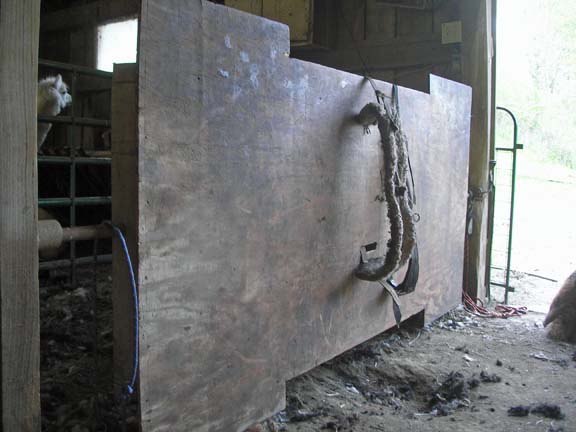Sometimes I just have to stop and marvel at the beauty in nature. This morning it was a spider web in a pine tree that was beaded with tiny drops of water. Kind of reminded me of my now finished beaded shawl .
Monday it was a gorgeous moth on a chair in the yard.
We still have a few alpacas to shear, 3 adults and 3 crias, although one of those 3 crias has yet to make its appearance. My older girl, Peg, is at 366 days gestation today. I'm getting anxious!
Unfortunately, I have not been able to get the shearing photos I'd like to have since I am always busy during shearing, but I do have some and can explain what we do.
Sheep shearers are fascinating to watch. They grab a sheep and bsically sit it up on it's butt with it's back up against their body and proceed to clip away, either with electric or hand shears. The sheep for the most part submits to this without too much fuss. They ARE sheep after all.
Alpacas on the other hand will definitely not sit still for that kind of treatment. In general, they do not like to be confined, grabbed, handled or even petted. Therefore, shearing, which requires all of the above is not their idea of fun. Alpacas have long legs and can pack a nice kick. Each foot is tipped with 2 raptor-like toenails, capable of shredding a T-shirt and scratching skin (ask Sam, he knows). So in the US we have devised ways to restrain alpacas for shearing which is safe for both the alpaca, the shearer and anyone else who might be in the barn. We even attempt to contain the spit which inevitably flies when an alpaca gets mad enough. "Mad enough to spit" takes on a whole new meaning!
In order to make our fleeces as nice as possible and to cut down on the wear on our shear combs and cutters, we try to get as much dust and debris off each animal prior to shearing. Yes, my Kirby vacuum cleaner lives in the barn during shearing season, so don't expect to come over and find my carpets clean! Each alpaca is brought into a catch pen and vacuumed as thoroughly as possible. Do they like this? No, not really and some protest vehemently. This is where kicking is likely to happen.

Once cleaned up, the alpaca is lead to our homemade shearing table, which tilts to vertical. There are 2 straps on the table which are fastened around the alpaca's belly, and then we tilt the table so it is horizontal and the alpaca is laying on its side. Now we need to restrain those legs, and we have a set of ropes for the front legs and one for the back legs which are attached to a ratchet device, allowing us to stretch the alpaca out on the table. This does not hurt them, it merely annoys them!
Once on the table, Sam goes to work with the shears while I hold the head to control the animal. Hopefully we have friends present to help with gathering up the fleece as it comes off the animal. We can get up to 10 pounds off each animal, with 6 being average. Here are 2 views of the same alpaca on the table being shorn. The fiber (as the fleece is called) is separated into 2 bags , prime (or the best part) and seconds. Anything unusable goes on the floor and is raked out the door for the birds to use.
While the alpacas are mostly immobilized on the table, we try to take care of other unpleasant chores, such as toenail trimming.
This is also a good time to vaccinate and check teeth. We need to trim teeth from time to time on some animals and males have sharp fighting teeth that need to be cut off or they are known to use them to emasculate their rivals/pasturmates!
Most alpacas take this process with little complaint, but some scream through the whole thing as if they were being flayed alive. Some urinate all over the table, others spit. Occasionally we get a truly prolific spitter which requires that one of Sam's old socks be put to use. We had one such girl this year who literally filled a tube sock with foul green spit. This stuff could be used in chemical warfare. It is stinky and nasty. Basically, the alpaca regurgitates partially digested grass and can project this concoction an amazing 6 feet. The photo to the right is Elli, and while she did not require a sock, you can see her green lips and the green stuff that has dribbled out of her mouth as we were working on her.
From the time we bring an alpaca into the catch pen until we turn her loose back in the pasture, having experienced a full spa treatment, it is about 20 minutes. Sam and I are so thankful to have friends who don't mind getting dirty and come over to help us with this chore. We usually have a lot of fun and food and drink follows the job.
As mentioned earlier in this post, I finished my mystery shawl this week! Yeah! The edging took me almost a month, but it required knitting on 2800 tiny beads! I am very pleased with the result. I think it came out beautiful. Next project? I have a summer top I am working on in a hemp blend and some socks and and and........









No comments:
Post a Comment